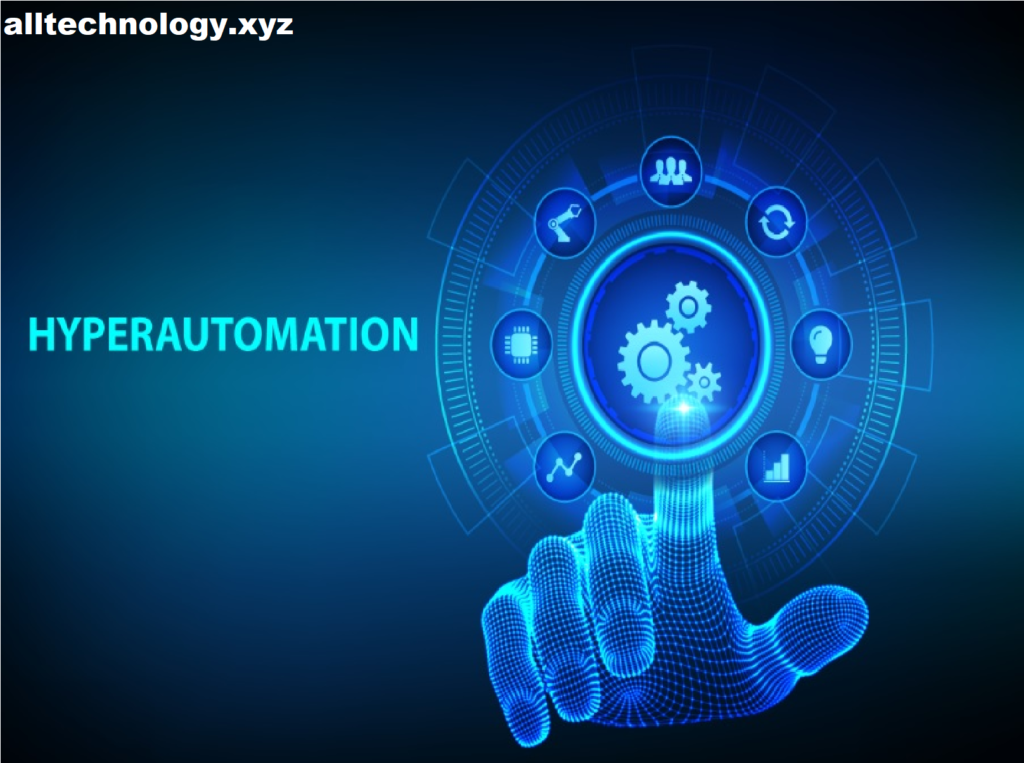Introduction:

In a rapidly evolving digital landscape, organizations are constantly seeking ways to enhance productivity, streamline processes, and stay competitive. Hyper-automation—an advanced approach that combines various automation technologies—has emerged as a transformative force reshaping the future of work. Leveraging artificial intelligence (AI), machine learning (ML), robotic process automation (RPA), and advanced data analytics, hyper-automation enables businesses to automate end-to-end processes, allowing for greater efficiency, accuracy, and agility. As organizations increasingly embrace hyper-automation, it promises to redefine work and unlock new growth opportunities.
1. Understanding Hyper-Automation
Hyper-automation goes beyond traditional automation by utilizing multiple technologies to automate complex workflows and decision-making processes. It doesn’t replace human input entirely; instead, it collaborates with human capabilities, amplifying productivity. By integrating various intelligent tools like AI and RPA, hyper-automation allows for adaptive learning and sophisticated problem-solving capabilities, which are critical in today’s fast-paced environment.
Key components of hyper-automation include:
- Robotic Process Automation (RPA): Automates repetitive, rule-based tasks with minimal human intervention.
- Artificial Intelligence and Machine Learning: Provides intelligent insights, predictive analytics, and autonomous decision-making.
- Process Mining and Analytics: Helps organizations analyze and optimize their workflows, identify bottlenecks, and enhance efficiency.
2. The Benefits of Hyper-Automation in the Workplace
- Increased Efficiency: Hyper-automation can drastically reduce time spent on repetitive tasks, allowing employees to focus on high-impact activities. Processes that traditionally took days or weeks can now be completed in minutes.
- Enhanced Accuracy and Consistency: By eliminating human error in mundane tasks, hyper-automation ensures consistent and accurate results, especially in data-sensitive operations like finance, compliance, and customer support.
- Cost Savings: By reducing manual labor costs and minimizing operational inefficiencies, hyper-automation can significantly lower expenses.
- Scalability and Flexibility: Hyper-automation is adaptable, allowing organizations to scale operations without proportionally increasing resources.
- Improved Decision-Making: With real-time data analysis and insights, hyper-automation enables organizations to make informed, strategic decisions quickly.
3. Impact on Workforce Dynamics
As hyper-automation becomes more prevalent, it inevitably reshapes workforce dynamics. The nature of work is shifting from task-based roles to value-driven roles where human skills such as critical thinking, creativity, and emotional intelligence become paramount.
- Re-skilling and Upskilling: As automation handles repetitive tasks, employees are freed up for more strategic, creative, and analytical roles. Companies must invest in training programs to upskill employees in areas like data analysis, problem-solving, and technology management.
- Workforce Optimization: Hyper-automation allows for greater flexibility, enabling remote work and facilitating global talent access. It can also lead to more flexible and efficient staffing models, where resources can be allocated dynamically based on real-time needs.
4. Challenges of Adopting Hyper-Automation
While the benefits of hyper-automation are significant, organizations must address certain challenges to ensure a smooth transition.
- Integration Complexity: Integrating multiple automation technologies can be complex, requiring seamless compatibility among systems.
- Security Concerns: Hyper-automation increases data flow between systems, raising potential security risks and the need for robust cybersecurity measures.
- Change Management: Transitioning to hyper-automation may cause resistance from employees who fear job displacement. Clear communication and training are crucial for easing this transition.
- Ethical Considerations: As automation grows, companies must consider ethical issues surrounding data privacy, bias in AI-driven decisions, and the potential displacement of traditional job roles.
5. Future Prospects and Industry Applications
Hyper-automation is already making a profound impact across various industries, each leveraging it for different applications:
- Healthcare: Hyper-automation in healthcare enhances patient care through streamlined diagnostics, patient record management, and predictive healthcare analytics.
- Finance: Financial institutions benefit from automated compliance checks, fraud detection, and enhanced customer service through chatbot-driven interactions.
- Manufacturing: In manufacturing, hyper-automation optimizes production lines, predictive maintenance, and supply chain management.
- Retail: Retailers use hyper-automation for personalized customer experiences, inventory management, and demand forecasting.
6. Preparing for a Hyper-Automated Future
Organizations aiming to stay competitive must prepare for a hyper-automated future by adopting a strategic approach:
- Develop a Clear Automation Strategy: Align automation goals with business objectives, focusing on where automation can drive the most value.
- Invest in Workforce Development: Equip employees with the skills necessary to work alongside advanced technologies.
- Adopt Agile Methodologies: An agile approach allows organizations to quickly adapt and implement changes based on new insights, maximizing the impact of hyper-automation.
Conclusion:
Hyper-automation is more than just a trend; it is a catalyst for redefining the future of work. By embracing hyper-automation, organizations can unlock unprecedented efficiencies, adapt to rapidly changing environments, and foster a workforce capable of driving innovation. With careful planning, upskilling, and a focus on responsible implementation, hyper-automation promises a future where human creativity and technological capability coexist harmoniously, propelling businesses to new heights.

